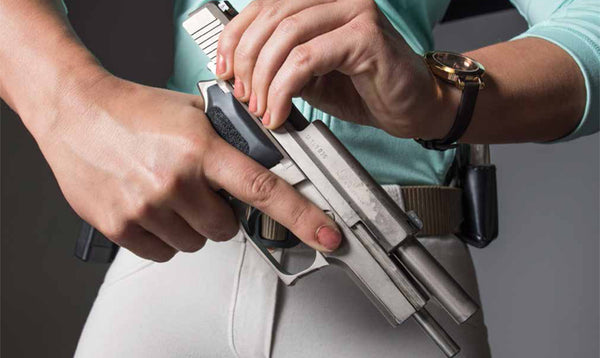Start at the Beginning: The Essentials of Handling a Handgun By George Harris // 05/16/2018
Posted on May 21 2018

AS AN INSTRUCTOR, establishing some common ground with your students through effective communication is of paramount importance in conducting effective training. It may sound overly basic, but almost all problems experienced in firearms instruction can be traced back to a failure to do so.
Safety
The objective is to ensure that a student, prior to touching or handling a gun, understands the terms we use and what specifically is being addressed. Nomenclature — the names of the parts or areas of a firearm — is essential to the safe handling and operation of a gun.
The muzzle should be addressed first, because that’s where the bullet exits the gun. Therefore, it should be emphasized that muzzle direction must be given constant attention. This attention will lead to the safe handling of the firearm, as well as the highly sought-after goal of hitting the target.
Fingers and other objects should be kept clear of the trigger until the student consciously intends to fire the gun.
The trigger follows closely behind the muzzle, because it is the mechanism that causes the bullet to exit the muzzle. The gun won’t fire without a pulling of the trigger, meaning fingers and other objects should be kept clear of the trigger until the student consciously intends to fire the gun.
The second part of the equation of handling a firearm (following, of course, safety) is hitting the target. All this requires is moving the trigger to the point of discharge without moving the muzzle off of the target. Just these two things will allow the student to enjoy safety and success in a relatively short period of time, but there are other important considerations regarding the handling of a pistol or revolver of which that student must be aware.
Operating the Gun
We teach that the gun should be verified clear and empty — visually and physically — when the student is first introduced to a firearm. Here, the student needs to know how to remove the source of ammunition and open the action for inspection or, in the case of a revolver, open the action first and then remove the ammunition.
Releasing the magazine or opening the cylinder rarely poses a problem for the student, but locking the slide open on a semi-automatic pistol can be challenging. Unquestionably, it is a necessary skill a student must master in order to safely unload the gun and verify it clear and empty. There are multiple techniques to accomplish this feat — both right-handed and left-handed — which the properly prepared instructor should know and be able to demonstrate.
Successful one-handed operation of a handgun in manipulation and shooting should be an early goal of a student.
Should the student not have the physical skills to unload and perform a visual and physical safety check of the firearm with which he or she is working, it is likely time to switch to a gun he or she can operate properly. Never forget that safety is not negotiable when handling firearms.
It is essential that the student be able to manipulate the buttons and operating levers on a handgun — magazine releases, manual safeties and decocking levers — in the manner in which they are intended to be used. A case in point that we see more than we would like is a student with a single-action pistol equipped with a thumb safety so stiff or small that it requires two hands to disengage and re-engage. This won’t work for a person intending to use the gun for defensive purposes. Successful one-handed operation of a handgun in manipulation and shooting should be an early goal of a student, particularly if his or her aspirations extend beyond recreational shooting.
Loading and Unloading
The ability to properly and effectively load magazines is essential to handling a semi-automatic pistol. While techniques to partially load a magazine are relatively simple, loading a magazine to full capacity can be a challenging task. Fortunately, there are loading devices on the market that aid a shooter in doing so. Nevertheless, a student should strive to fully load magazines on demand, just in case he or she doesn’t have access to an aid. An expanded-capacity handgun doesn’t fulfill its role without a full complement of ammunition.
For a student who is unable to lock the slide open easily or at all, manipulate the operating levers or load magazines, the revolver might be the best option. A revolver is simple to operate and as safe to handle as any firearm. The only real downside is a cartridge capacity somewhat lower than most pistols.
The added benefit of “topping off” reinforces the knowledge that there’s a round in the chamber.
Putting the gun into operation — loading the gun so it’s ready to fire — is another essential handling feature that a shooter must understand and accomplish with little difficulty. The sequence of verifying the gun’s status prior to loading, executing the loading procedure and topping off the magazine is essential to maximizing the carrying potential of the semi-automatic pistol; the added benefit of “topping off” reinforces the knowledge that there’s a round in the chamber.
Unloading mimics the actions of performing a visual and physical check by removing the magazine first, then locking the slide to the rear to inspect the chamber, magazine well and breech face for ammunition. Since the gun was loaded, the shooter should watch for the round that was in the chamber to be extracted and ejected from the pistol.
Starting Point
The bare essentials of handling a firearm start with safety, putting the gun into operation, taking it out of operation and verifying it as safe. These essentials are necessary prior to learning to perform field-strip maintenance, reloads, immediate-action drills and working from a holster as the student becomes more proficient with his or her firearms and equipment.
As an instructor, take these perspectives and add your own flavor as the situation and class dictate. With the above as a guide, you and your students should find safety and success.


0 comments